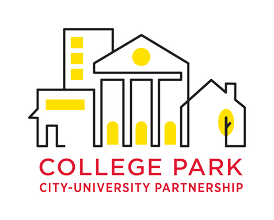
Vision 2030: Transformation by Design
And just like that, summer is winding down here in College Park. As summer fades away and the fall semester kicks off, a renewed energy is palpable throughout the town. Students are trickling back to campus, bringing with them a vitality that complements the lingering buzz of those savoring their last summer moments. I’m struck by the transformations that have taken place over the summer months and wonder if others see the exciting evolution underway. These changes are more than mere updates—they represent a grand, intentional redesign of College Park, guided by the University-Community Vision 2030 initiative.
The Vision 2030 Initiative
The Vision 2030 plan emerged from a collaborative effort spearheaded in 2020 by the Partnership, the City of College Park, the University of Maryland, and various community stakeholders. This strategic blueprint was crafted to align collective actions with shared goals across several key focus areas: Transportation & Mobility, PreK-12 Education, Housing & Development, and Public Health & Safety. It represents a comprehensive approach to community and economic development, grounded in long-term planning and committed to transformative results.
The progress made under this initiative reflects the dedication of countless individuals and organizations over the years (decades for some!). As we reflect on the strides achieved thus far, it’s essential to celebrate the successes and acknowledge the ongoing challenges and fresh priorities. This issue of The Partnership highlights notable transformations currently underway in College Park and showcases a few of the tangible accomplishments towards realizing Vision 2030‘s goals.
Transportation Improvements: A New Era of Connectivity

Among the most visible changes in College Park are the substantial transportation upgrades along Baltimore Avenue. Scheduled for completion this fall, this project has been decades in the making and promises to enhance connectivity and accessibility throughout the city. The redesigned corridor aims to streamline traffic flow, alleviate congestion, and provide a smoother commute for both residents and visitors. Over the years, advocates for these improvements have included City leaders and elected officials, members of the 21st delegation, UMD leaders and community stakeholders. The Partnership is proud to have contributed to this collective effort to address critical design and safety needs.
Significant improvements include dedicated bicycle lanes and pedestrian pathways, which reflect a commitment to sustainable and inclusive transportation options. Additionally, new street plantings will introduce greenery, further enriching the streetscape. While ongoing construction of the Purple Line has been disruptive, the imminent completion of these upgrades is a testament to the community’s patience and perseverance.

A Surge of New Businesses
College Park is also experiencing an influx of new businesses, contributing to the city’s economic vitality and cultural vibrancy. Trendy cafes, innovative restaurants, and unique retail shops are opening their doors, adding to the city’s already thriving food scene and retail landscape.
I recently spent a morning working al fresco in the City Hall Plaza, and noticed a definite buzz in the air as students and families are returning to campus. New restaurants and shops reflect the rich mosaic of College Park, Prince George’s County and the DMV region beyond. The arrival of these new businesses is not only invigorating the local economy but also fostering a stronger sense of community and cultural richness. College Park’s unique blend of urban energy, suburban tranquility, and collegiate charm resonates widely.
Downtown: A Canvas of Culture and Creativity
Downtown College Park is undergoing a cultural renaissance, marked by a series of striking public art murals. These artworks are not just aesthetic enhancements—they are vibrant expressions of the city’s identity and creative spirit. Public art projects celebrate College Park’s rich heritage, contributing to a welcoming and dynamic atmosphere.
At the Partnership, we have received suggestions for new art installations across the city, and conversations are underway to bring even more creativity to public spaces. This emphasis on public art reflects College Park’s commitment to fostering a rich cultural scene while preserving its distinctive small-city charm.
Collective Efforts and Future Aspirations
As the fall semester begins and students return to campus, College Park stands as a testament to how a city can evolve through the collective efforts of its community institutions and stakeholders. The changes and developments we are witnessing are not merely about modernization—they are about enhancing the city’s vibrancy and ensuring a connected community where culture, tradition, and progress coexist.

At the Partnership, we take pride in our collaboration with the City of College Park and the University of Maryland. We are committed to driving these efforts forward as set forth in Vision 2030. While we acknowledge there is still work to be done to fully realize these goals, we are excited about the progress to date and look forward to continued partnership with the community, the City and the University.
Vision 2030 represents more than a set of goals; it embodies a shared vision for a thriving, inclusive, and dynamic College Park. As we continue to build on this foundation, we remain committed to celebrating our successes, addressing challenges, and pursuing the transformative potential that lies ahead. Together, we are shaping the future of College Park—one designed with intention and driven by collective aspiration and action.
